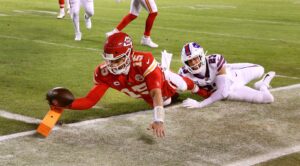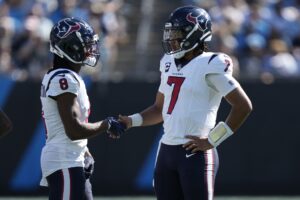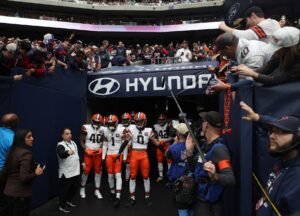Trends are simultaneously friendly and scary; they reveal patterns, but that is only useful if the pattern receives a solution. Trends are storms brewing on the horizon, but foresight allows the storm to be avoided if the captain derails the boat’s path in time. Hence, trends ought to receive attention and not be dismissed as tiresome worry. In the NFL, trends usually beget pivot, twists, and reshuffling to avoid the impending storm. However, if the storm is left to hit, it hits hard.
The Kansas City Chiefs felt the storm of trends hit in week 11 with a 12-9 overtime loss to the New York Giants. Every worrisome trend and sign shook the core of a flat performance in MetLife Stadium as the Chiefs played without personality or concern for their own brevity of style. The Kansas City Chiefs week 11 stats were not only a singular movement of depravity, but a symphony of trends playing in full tone. Standing at the halfway point of the season, there are two options for the Chiefs: improve and mitigate trends, or dwindle away opportunity as they delve deeper into the storm.
Kansas City Chiefs Week 11 Stats and Charts – Reality is Now Trending
Chaos Theory
The mistakes against the Giants were a micro-trend of confusion in their own right. Sunday’s loss was not only representative of seasonal trends, but among the worst mistakes in the Andy Reid era. The meta line of the game was not that either team failed to capture chaos – in a fractal sense it appeared just as a high scoring game – but the plethora of moments could have captured chaos, but failed to.
Heading into the game as 10-point favorites, the Chiefs were expected to do anything but twiddle their thumbs on the first drive. Yet, after Alex Smith found Travis Kelce for a big gain, Kareem Hunt was met with a brick wall and the short-pass game was impressively short. Check down Charlie would have been proud.
The Giants attempted to take advantage of the Chiefs lack of urgency by putting together a 12-play drive. Eli Manning was exquisitely painting the defense while Orleans Darkwa established momentous runs. In the red zone, when chaos was in full control of the Giants, a terrible trick-play call letting running back Shane Vereen pass resulted in Daniel Sorensen intercepting the duck of a throw.
A lesson the Chiefs learned before, cute play calls allow too much risk in chaos theory. The Giants mistake gave Reid a mulligan on their first drive. However, instead of finding the bunker, Smith found the Sinai Peninsula. The impressively short passing game turned into an interception as defensive tackle Damon Harrison tipped and intercepted the ball.
The resulting 26-yard trip to the end zone was an easy trip for the Giants to putt in a touchdown, especially after Marcus Peters committed an egregious pass interference penalty. The mental mistakes, however, carried over to the Giants as kicker Aldrick Rosas missed the extra point. Again, chaos was in either team’s hands at this point. However, the trend was showing the Chiefs were going to be making mental mistakes the rest of the day.
More than mental mistakes, however, carried over the remaining 43 minutes. The Chiefs attempted to put together a successful drive, but shot themselves in the foot with mental penalties twice, negating explosive plays. The result was a mere 31-yard field goal from Harrison Butker, the sole spotlight in the first half.
The second half was no better. Both teams danced around opportunity if the year were 1920. In some regards, 1930s football was fundamentally more entertaining. The Chiefs finally managed a field goal in completing after a deep pass to Tyreek Hill, but the meta trend of short, non-expressive passes continued. The Chiefs intrinsically did not create opportunity due to check-downs met with reverberating tackles.
Two more befuddling moments occurred before overtime. The first was a repeat mistake of the cute ‘non-quarterback’ throwing deep – this time it was Kelce who threw a duck only to be intercepted. The second was an egregious interception from Smith as he tried to fit a square in a passing window named Janoris Jenkins; a mistake many quarterbacks have learned not to make.
Overtime was a capitulation of the worst of regulation. The Giants ineptitude as an overriding storyline broke, and Manning played back yard football on the way to a methodical, winning field goal. The complete lack of urgency from either the offense or defense in overtime was essentially handing chaos, and the win, over to the Giants.
Mediocre Inefficiency
Smith and company were not only mediocre, they were mediocre about being inefficient. Any opportunity they had to score was quickly erased due to penalties or turnovers. The performance from Smith alone was enough to convict the Chiefs to a death sentence: simple models show that when passing 40 or more times and committing two or more turnovers, winning percentages lower to a mere 20.
Then, there was the profound error at the end of regulation covered up by the hope of overtime. On the second to last play in regulation, Smith took the snap with one timeout left, could not see an open receiver, and instead of killing the clock, scrambled for seven yards. A positive net play, but a play that stole time and another passing opportunity off the docket. Perhaps that mental error is emblematic of the entire trajectory of the game.
An out of-sync passing offense provided the first problem the Chiefs failed to mitigate. Hunt’s targets stand as the prime example. He has averaged 9.6 yards per reception on the year. Hence, Hunt is usually used in the middle of the field as a sure first down target. Yet, on Sunday, he saw four targets for three receptions for 1.33 yard per reception. Even more astounding was his average target came one yard downfield.
Two problematic implications are derived. First, Smith was targeting Hunt as a safety vault while under pressure. Second, plays were not developing fully. Hunt is preferably targeted five or more yards down field so he can create another four to five yards with his relentless work ethic. The Giants negated yards after the catch by swarming to the ball with finesse tackling. Defensive coordinator Steve Spagnuolo was prepared, and Reid failed to transition in play calling.
Those overriding problems were exemplified in Hill as well – he saw 9.71 yards per target and 9.71 yards per catch. Whether it was De’Anthony Thomas or Charcandrick West, Smith was passing to lanes that were closed or had linebackers floating in anticipation of tackling.
Furthermore, deep passing was no option of improvement. On seven deep targets, he completed three for 91 yards. When the Chiefs were rolling early in the season, Smith attempted only three to four deep passes. Forcing deep passes is indicative of a desperate and failed Chiefs offense.
However, the statistical nuance of the “deep ball” is a mere distraction from the real problem. Expecting Smith to be perfect when passing deep down the field is not fair. In fact, since week six, he has been above average passing deep with a 158-rating deep left (78 percent completion), a 96-rating deep middle (50 percent completion), and a 91-rating deep right (23 percent completion).
Build in context and those stats lose their fervor. The deep passes have come at desperate times in “too little, too late” movements. The high leverage amplitude failed to generate success against the Giants, just as in other weeks. In the offensive scheme, long passes are forced upon having failed on higher percentage, short routes, attempts earlier in the game.
The problem is the grinding short-passing game Reid loves to build off run play formations. Since week six, Smith has a below average to average rating (79 left, 74 middle, 94 right) in short passes, emblematic of poor decision making to let athletic weapons create opportunity. On third downs, the highest leverage situations inside of games, the rating degrades to 53 left, 42 middle, 105 right.
There is no overriding success forcing opponents to respect the short game, resulting in tightly covered deep, zone segments.
The run game may have produced 134 yards, 73 yards from Kareem Hunt on 18 attempts, but the detailed calls also failed to generate any respect for the short game. Only half of Hunt’s carries came on rhythmic play call sets (back to back runs). Meanwhile, drives were commonly isolated to either running or passing sets, showing a lack of variety in play format for individual drives.
Predictability, a lack of urgency, and failed generation doomed the Chiefs offense.
A Storm of Trends
At the end of the game, points win games. The Chiefs defense was not spectacular or shiny through the first 60 minutes of regulation, but they held the Giants to a mere nine points. Even holding bad offenses to minimal output is worthy of an accomplished job.
All being said, overtime dismissed any notion that the Chiefs defense was playing respectable football. The Giants were merely twiddling their own thumbs in regulation. In high leverage situations, the most poignant units are expected to be the key. For the Chiefs, that is their defense in the fourth quarter and overtime, and they bluntly failed. The overtime stat line only extrapolates how detrimental and boring the Chiefs defense was.
Darkwa and Wayne Gallman combined for three carries and 15 yards, Bennie Logan provided another five yards on an encroachment penalty, and Manning completed four of five agile throws, including a precisely placed ball to Roger Lewis over the shoulder of Peters. The catch was even more improbable. Peters committed pass interference by shoving Lewis away from the ball, yet Lewis managed to balance the ball on his fingertips centimeters from the ground. Rosas’ job was made easy on a 23-yard game winning field goal.
Overtime represented the mental mistake trends of the game and the institutional lack of urgency seen throughout the season. Manning was not pressured once in overtime, and rarely was met with pressure throughout the game. The Giants, owning one of the worst offensive lines in football, kept Manning upright as the Chiefs generated zero sacks.
A lack of pressure has been a meta trend on the season, especially in the second half. That trend is now becoming a disastrous storm, powerful enough to kill the Chiefs playoff hopes. With only 19 sacks on the season, many coming in the first few games, the playoffs will be a a dud if quarterbacks Tom Brady or Ben Roethlisberger are kept clean all day long. Nay, the playoffs will not be seen if average quarterbacks are kept clean.
The lack of urgency from the edges is not only awful for the Chiefs success, but the inherit structure of the salary cap. 21.43 percent of the salary cap, roughly $36,626,452, are tied up in pass rushing units. Since week five, the Chiefs have only eight sacks coming in spurts. Three of those came against the Denver Broncos, and another three against the Houston Texans. Inconsistency and injuries to Dee Ford and Tamba Hali are haunting the team. If this trend continues past 2017, a complete defensive restructuring may be in order.
A holistic lack of purpose from the Chiefs rush defense poured over into the matchup as well. Gallman and Darkwa were a key cog to the Giants 32 team carries for 112 yards. On occasion, a backfield collision was reminiscent of a more powerful Chiefs defense. Yet, in the opportune situations, one of the two would truck onward for a net gain and momentum turning play. Darkwa only saw two explosive runs, and Vereen one himself, but at the end of the day four yards on second down is enough to keep drives alive.
The Giants grinded the ball and were not scared away from their strategy. Against better units, these trends will be magnified. Unless something, or someone, takes responsibility, the Chiefs defense is walking into the eye of a storm.
Main Image:






